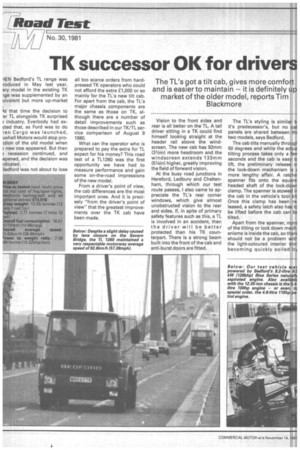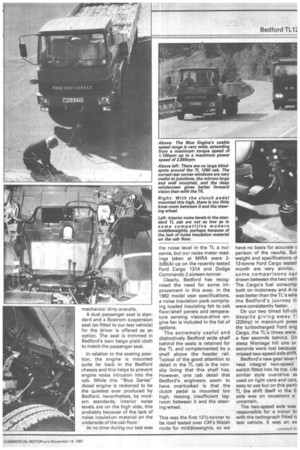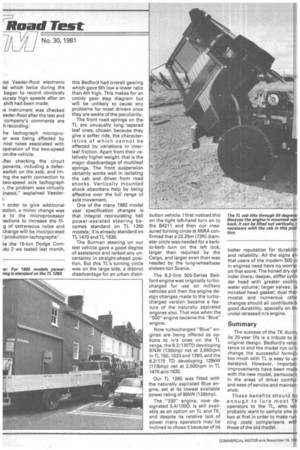TK successor OK for drivers
Page 68

Page 69

Page 70

If you've noticed an error in this article please click here to report it so we can fix it.
The TL's got a tilt cab, gives more comfort and is easier to maintain — it is definitely up market of the older model, reports Tim Blackmore
-IEN Bedford's TL range was roduced in May last year, ary model in the existing TK Ige was supplemented by an uivalent but more up-market that time the decision to er TL alongside TK surprised ) industry. Everbody had excted that, as Ford was to do len Cargo was launched, uxhall Motors would stop proction of the old model when new one appeared. But then ) recession continued, and epened, and the decision was hdicated.
3adford was not about to lose all too scarce orders from hardpressed TK operators who could not afford the extra £1,000 or so mainly for the TL's new tilt cab. For apart from the cab, the TL's major chassis components are the same as those on TK, although there are a number of detail improvements such as those described in our TK/TL service comparison of August 9 1980.
What can the operator who is prepared to pay the extra for TL expect for his money? This road test of a TL1260 was the first opportunity we have had to measure performance and gain some on-the-road impressions of the new model.
From a driver's point of view, the cab differences are the most important ones. And it is precisely "from the driver's point of view" that the greatest improvements over the TK cab have been made.
Vision to the front sides and rear is all better on the TL. A tall driver sitting in a TK could find himself looking straight at the header rail above the windscreen. The new cab has 92mm (31/21n) more headroom and the windscreen extends 133mm (51/4in) higher, greatly improving the field of forward vision.
At the busy road junctions in Hereford, Ledbury and Cheltenham, through which our test route passes, I also came to appreciate the TL's rear corner windows, which give almost unobstructed vision to the rear and sides, If, in spite of primary safety features such as this, a TL is involved in an accident, then the driver will be better protected than his TK counterpart. There is a strong beam built into the front of the cab and anti-burst doors are fitted. The TL's styling is similar tc it's predecessor's, but no cal panels are shared between thi two models, says Bedford.
The cab tilts manually through 50 degrees and while the actua tilting process takes only a fey seconds and the cab is easy tt lift, the preliminary release o the lock-down mechanism is more lengthy affair. A ratche spanner fits onto the square headed shaft of the lock-dowr clamp. The spanner is stowed ir the cab in the vehicle's tool kit Once this clamp has been re leased, a safety latch also has tc be lifted before the cab can bE tilted.
Apart from the spanner, nonE of the tilting or lock down mech anisms is inside the cab, so therE should not be a problem with the light-coloured interior trirr becoming quickly soiled bN mechanics' dirty overalls.
A dual passenger seat is standard and a Bostrom suspension seat (as fitted to our test vehicle) for the driver is offered as an option. The seat is trimmed in Bedford's own beige plaid cloth to match the passenger seat.
In relation to the seating position, the engine is mounted quite far back in the Bedford chassis and this helps to prevent engine noise intrusion into the cab. While this "Blue Series" diesel engine is reckoned to be the quietest ever produced by Bedford, nevertheless, by modern standards, interior noise levels are on the high side, this probably because of the lack of noise insulation material on the underside of the cab floor.
At no time during our test was the noise level in the TL a nuisance, but our noise meter readings taken at MIRA were 23dB(A) up on the recently tested Ford Cargo 13'14 and Dodge Commando 2 sixteen-tonner.
Clearly, Bedford has recognised the need for some improvement in this area: in the 1982 model year specifications, a noise insulation pack comprising loaded insulating felt to cab floor/shelf panels and temperature sensing viscous-drive engine fan is included in the list of options.
The extremely useful and distinctively Bedford wide shelf behind the seats is retained for the TL and complemented by a shelf above the header rail. Typical of the good attention to detail in the TL cab is the nonslip lining that this shelf has. However, one cab detail that Bedford's engineers seem to have overlooked is that the clutch pedal is mounted too high, leaving insufficient legroom between it and the steering wheel.
This was the first 121/2-tonner to be road tested over CM's Welsh route for middleweights, so we
have no basis for accurate c parison of the results. But weight and specifications oi 13-tonne Ford Cargo tested month are very similar, some comparisons car drawn between the two vehii The Cargo's fuel consumv both on motorway and A-ro was better than the TL's whe the Bedford's journey ti were consistently faster.
On our two timed hill-clir despite giving away 1; (22bhp) in maximum powE the turbocharged Ford eng Cargo, the TL's times were a few seconds behind. On steep Wantage hill one or seconds were lost because missed two-speed axle shift.
Bedford's new gear lever t neat integral two-speed switch fitted into its top. Ulm similar style overdrive sv used on light vans and cars, easy to use but on this panic TL the shift itself in the E. axle was on occasions a uncertain.
The two-speed axle was responsible for a minor hi. with the tachograph fitted tc test vehicle. It was an ex rtal Veeder-Root electronic lel which twice during the began to record obviously curate high speeds after an shift had been made.
ie instrument was checked eeder-Root after the test and company's comments are :h recording:
he tachograph microproor was being affected by :rical noise associated with operation of the two-speed on,the vehicle.
■ fter checking the circuit ponents, including a defecswitch on the axle, and iming the earth connection to two-speed axle tachograph t, the problem was virtually mated," explained Veedert.
order to give additional action, a minor change was e to the microprocessor lections to increase the Ng of extraneous noise and change will be incorporated I production tachographs".
ke the 16-ton Dodge Corndo 2 we tested last month, this Bedford had overall gearing which gave 5th low a lower ratio than 4th high. This makes for an untidy gear step diagram but will be unlikely to cause any problems for most drivers once they are aware of the peculiarity.
The front road springs on the IL are unusually long tapered leaf ones, chosen because they give a softer ride, the characteristics of which cannot be affected by variations in interleaf friction. Apart from their relatively higher weight, that is the major disadvantage of multileaf springs. The front suspension certainly works well in isolating the cab and driver from road shocks. Vertically mounted shock absorbers help by being effective over the full range of axle movement.
One of the many 1982 model year specification changes is that integral recirculating ball power-assisted steering becomes standard on TL 1260 models; it is already standard on TL 1470 and TL 1630.
The Burman steering on our test vehicle gave a good degree of assistance and lacked any uncertainty in straight-ahead position. But this TL's turning circle was on the large side, a distinct disadvantage for an urban distri
bution vehicle. I first noticed this on the tight left-hand turn on to the B4211 and then our measured turning circle at MIRA confirmed that a 22.25m (73ft) diameter circle was needed for a kerbto-kerb turn on the left lock, larger than. required by the Cargo, and larger even than was needed by the long-wheelbase sixteen-ton Scania.
The 8.2-litre 500-Series Bedford engine was originally turbocharged for use on military vehicles and then the engine design changes made to the turbocharged version became a feature of the naturally aspirated engines also. That was when the "500" engine became the "Blue" engine.
Now turbocharged "Blue" engines are being offered as options to n/a ones on the TL range, the 8.2/130TD developing 97kW (130bhp) net at 2,650rpm in TL 750, 1020 and 1260, and the 8.2/175 TD developing 129kW (173bhp) net at 2,500rpm in TL 1470 and 1630.
Our TL 1260 was fitted with the naturally aspirated Blue engine, set at its lowest available power rating of 95kW (128bhp).
The "330" engine, now designated 5.4/100D, it still available as an option on TL and TK, and despite its relative lack of power many operators may be inclined to chose it because of its
better reputation for durabilitl and reliability. All the signs an that users of the modern 500 CL in engines need have no worrie: on that score. The honed dry cyl inder liners; deeper, stiffer cylin der head with greater coolim water volume; larger valves; la minated head gasket; dual ther mostat and numerous othe changes should all contribute t( good durability, specially on thi under-stressed n/a engine.
Summary
The success of the TK durin its 20-year life is a tribute to it: original design. Bedford's reluc tance to end the model run or tc change the successful forrnuk too much with TL is easy to un derstand. However, in-mortar, improvements have been math with the new model, particularl) in the areas of driver comfor and ease of service and mainten ance.
These benefits Should bE enough to lure most TK Operators to the TL, who wil probably want to sample one oi two at first in order to make run• fling costs comparisons witlthose of the old rbodel.






















































































